Food Bank hits 40: Regional distribution center feeds a need that is growing
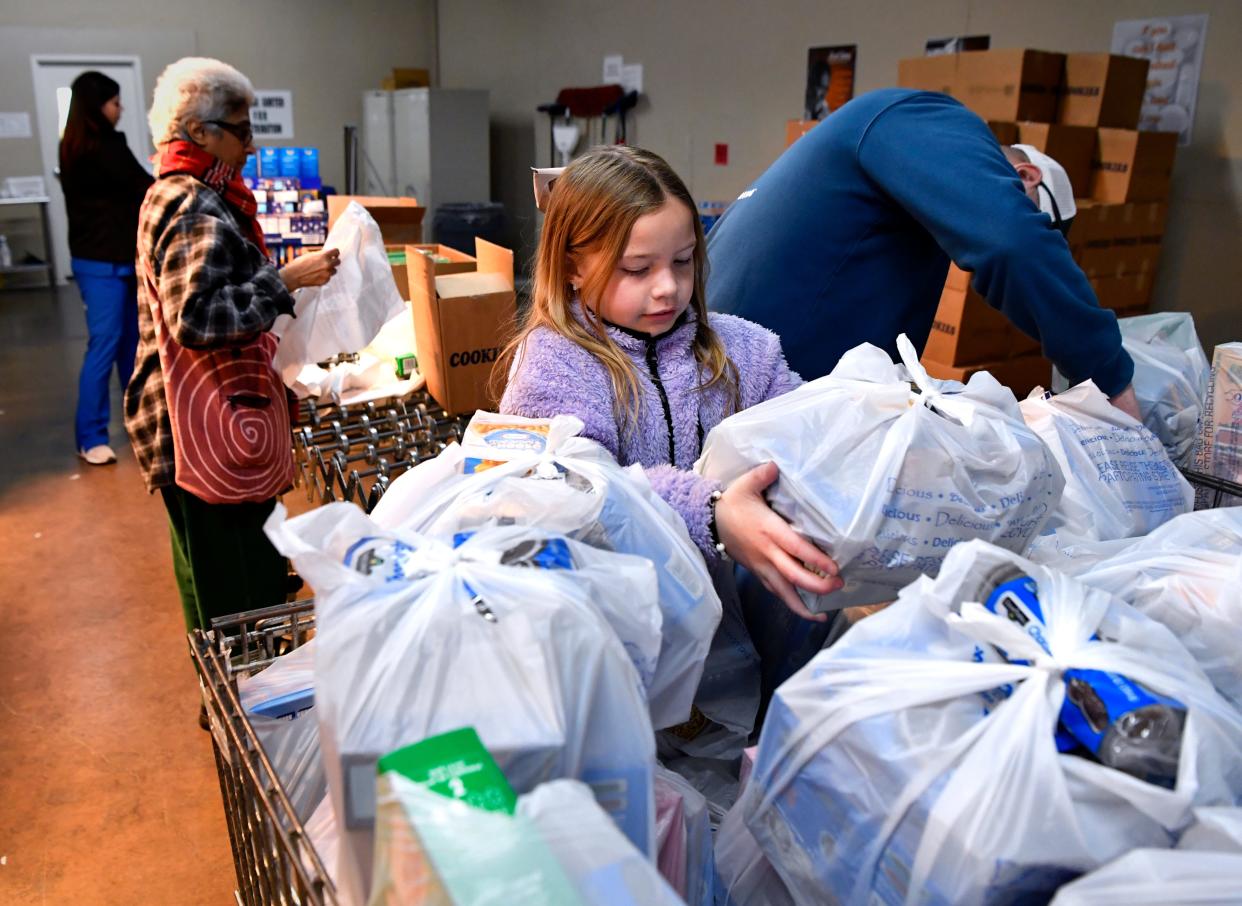
It's an anniversary year in Abilene for sure, and here's food for thought:
Food Bank of West Central Texas has been around for 40 years.
While the focus may be on McMurry University celebrating 100 years or Hardin-Simmons Cowboy Band about to do the same, the nonprofit tucked away on far North First Street, west of the Winters Freeway, has its own anniversary.
To milk the milestone for all its worth, the food bank is launching a $4 million campaign to expand its service with a drive-thru pickup area. That plan officially was announced March 17.
More:Abilene food bank's $4M expansion to extend hours, service to community
An idea born 40 years ago
The food bank traces its history to 1983, when Mary Frances Warren of the Texas Department of Public Welfare, Pete Ybarra of the local Community Action Program and Betty (then Blazier) Bradley of Meals of Wheels met to discuss how to address hunger issues in Abilene. They toured other food banks in Texas and created one here to serve not only the city but the surrounding area.
By Jan. 6, 1984, Food Bank of Abilene Inc. had found warehouse space on North First Street - a donation from Abilene National Bank - to store frozen items and that day launched an operation that exists on a greater scale now. The first headquarters, according to Reporter-News files, was on Arnold Boulevard.
The first donation to the food bank was 2,400 pounds of frozen meat from Gooch Packing Co. It's believed Meals on Wheels received the first food from the nonprofit.

Later that first year, country singer Kenny Rogers performed in Abilene and asked fans to bring non-perishable items to his October show at the Taylor County Coliseum.
"During my constant travels," the singer said, "I have come to understand how appalling and far-reaching the program of hunger is in America. With the food drive, we are trying to do something immediate and direct about feeding hungry people throughout the country."
Within the first year, according to food bank records, businesses donated 225,000 pounds of food. That was distributed to 25 agencies.
U.S. Rep. Charles Stenholm attended the first anniversary celebration in January 1985.
The facility began in small quarters but soon moved to its current location at 5505 North First St. Three expansions later, the facility has grown to 30,000 square feet, a building where food items are received, sorted and stored until being picked up or delivered.
It changed its name in 2005 to reflect its broad service area.
Today, the food bank partners with 150 agencies in 13 counties - from Mitchell County to the west to Eastland County to the east - that cover close to 13,000 square miles.
"Through the years, it has impressed me that there's always a need and it's always changing," said Ronnie Kidd, the five-year director of the food bank who was a board member before that. "While people may have a need today and it gets met, and maybe another need after that, there are other people who come in because of situations in their lives and need is created for them. So it's very dynamic and liquid.
"It's always a challenge to make sure people who need access to food can have it. Who our neighbors are who need help."
Ricky Carroll, who directs the United Methodist Food Pantry on North First Street, boiled it down.
"They are indispensable," he said.
Who gets served?
The service area roughly follows Interstate 20 but also includes Stephens County to the north and Brown and Runnels counties south of the highway. The most distant county is Comanche, also south.
"It started almost mom and pop and has grown to what we are today," said Patrick Dembach, director of operations.
Its mission statement is "Fighting hunger, feeding hope."
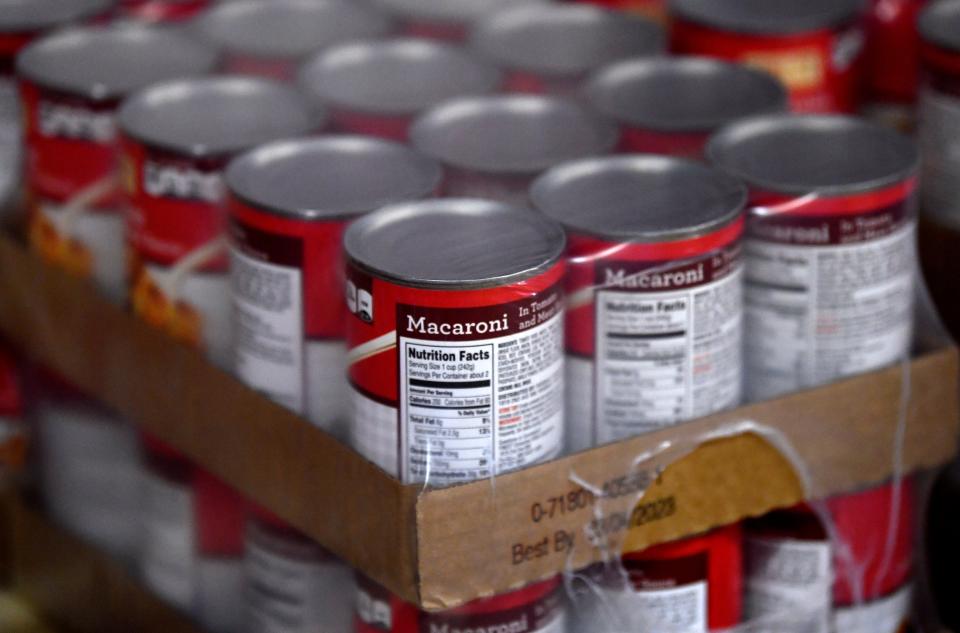
The food bank serves as the distribution hub for the partner agencies.
"Those partners will include food pantries, feeding programs and some schools with backpack programs in rural areas," he said. Mobile pantries are offered, too, where there is not an established program or a traditional grocery store, he said.
"When you get rural outside of Abilene, things shrink in terms of resources," Dembach said.
Where does the food come from?
The food bank has three primary sources of food"
Government commodities
General donations
Outright purchase of food
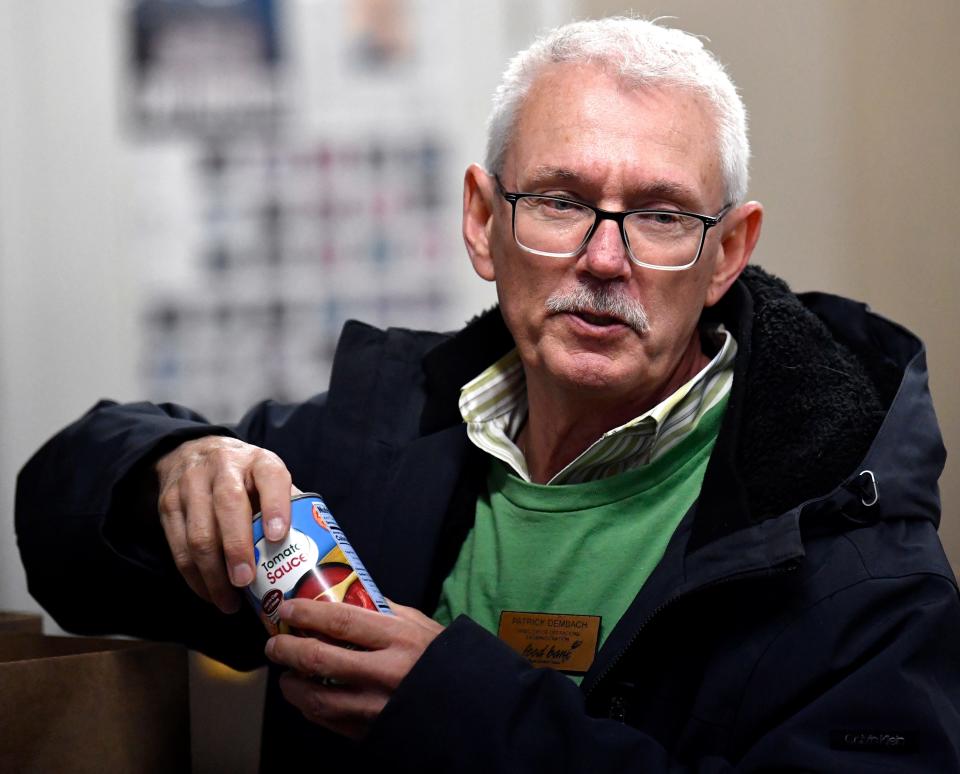
Donations, Dembach said, can take "any form, from retail recovery" or individuals or corporations who contributed financially or with food.
Many food products are not the name or even store brands that most shoppers know,
"After all these years," said Dembach, who has been with the local food bank for 16 years, "a donation can come in today of a product that I never have seen in the grocery store. It's a mystery.
"We have a wealth of generous donors, both of product and financial support. Without that, we could not function.
"That's kudos to the Big Country."
Kidd said the operation continues to change.
"You saw that a lot during the response to the pandemic and the supply chain interruptions," he said. "Our channels for receiving food are totally different now. The mix is different before the pandemic."
He said more food had to be purchased than was donated.
"That was the only way we could get it," Kidd said. "The sources for donations have changed or have dried up."
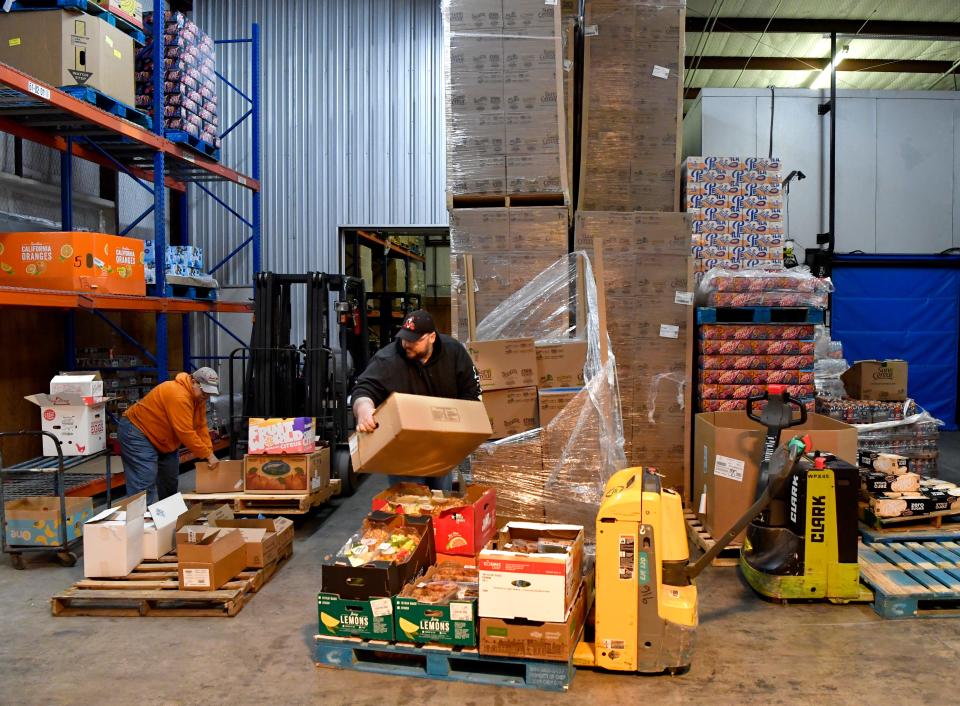
Donations that can accepted, or turned away
The food bank wants to provide "supplemental nutritious staples to those who are known, as the food cliche, as the food insecure," Dembach said.
There are core items Food Bank of West Central Texas would like to provide, based on demographics. These include items that residents of the Big Country are familiar with and know how to prepare.
∎ Pastas and grains. That includes dry beans or rice.
∎ Items that are shelf stable, but not contained in glass.
"We cannot take homemade products," Dembach aid. "No homemade pickles or jellies, unfortunately."
∎ Fresh produce. Those items can come from a garden, he said.
"We have people who donate pecans or pears ... zucchini, squash ... things like that," he said.

∎ Proteins. Peanut butter, canned meats such as tuna, chicken and beef stews.
"We do try to stock things of that nature," Dembach said. "We do love condensed soups because you can stretch those with rice, potatoes, pasta. It's a versatile product."
∎ Venison, but only if it has been through a processor.
∎ Dairy, but only items that have been processed.
What can't be accepted?
Eggs, "because I don't know how they have been stored," Dembach said.
Personally frozen items.
"You have hamburger meat in your freezer and you want to donate it, I can't accept it," he said. "I don't know how it has been handled."
The decisions are based on food safety and widely followed in the food banking world, Dembach said.
Feeding programs can use some of those items by cooking on the spot, he said.
Bottom line, Dembach said, is to think like stocking a home pantry. What people most often have in their cupboard likely is what the food bank would like to provide to the folks it serves.
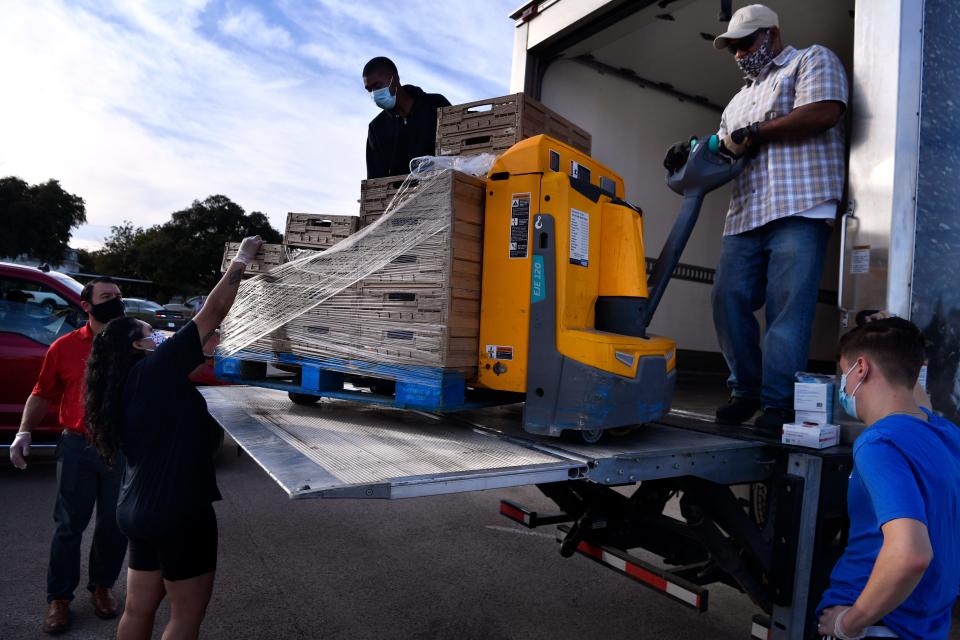
Supplemental needs met
Food bank items are supplemental, Dembach said again.
"We are a source for them," he said. "We are not always the primary source."
That is why the local food bank works with, for example, Love & Care Ministries, United Methodist Food Pantry and Presbyterian Food Pantry - Food Distribution Center, Salvation Army, City Light Ministries and Breakfast on Beech Street.
"It just goes on," Dembach said. "It makes no difference. As long as they are a 501(c), they are eligible to apply for membership.
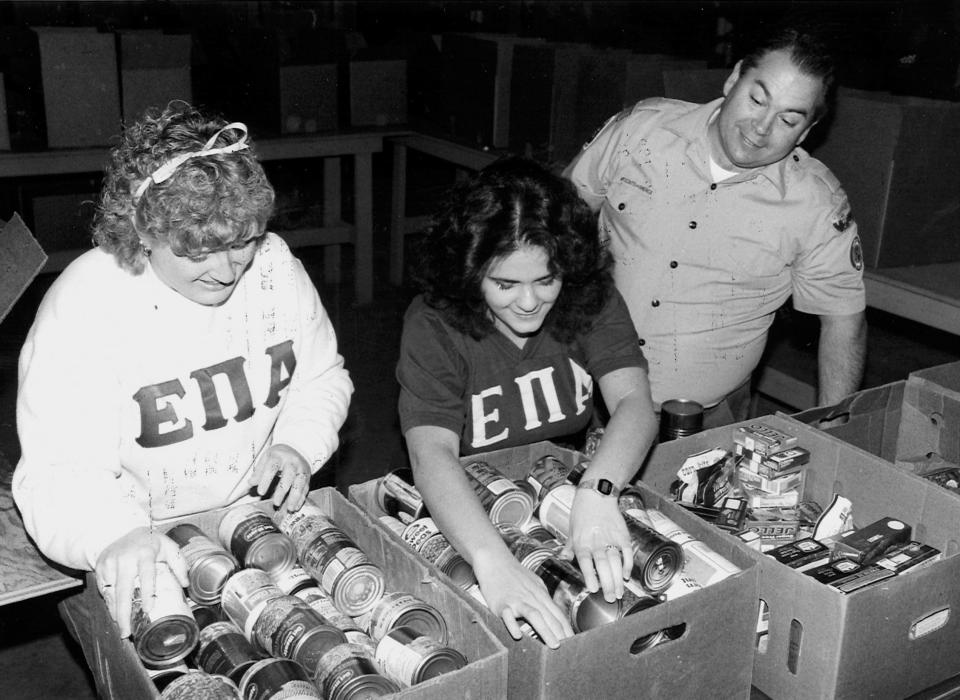
"We get 96 percent of our food from here," said Carroll of the Methodist food pantry, which is one of the largest of its kind in Abilene. The bulk pricing stretches their dollars, he said. He tells some who bring food directly to them that a cash donation would allow the food pantry to buy even more items.
"I come over every Wednesday with my order."
These partners operate independently and are supported in different ways , he said.
"It could be faith-based, it could be a community organization, or a group of friends who got together wanting to form a food pantry," Dembach said.
Are there too many organizations doing the same thing?
No, Dembach said.
Are they well organized?
Yes, he said.
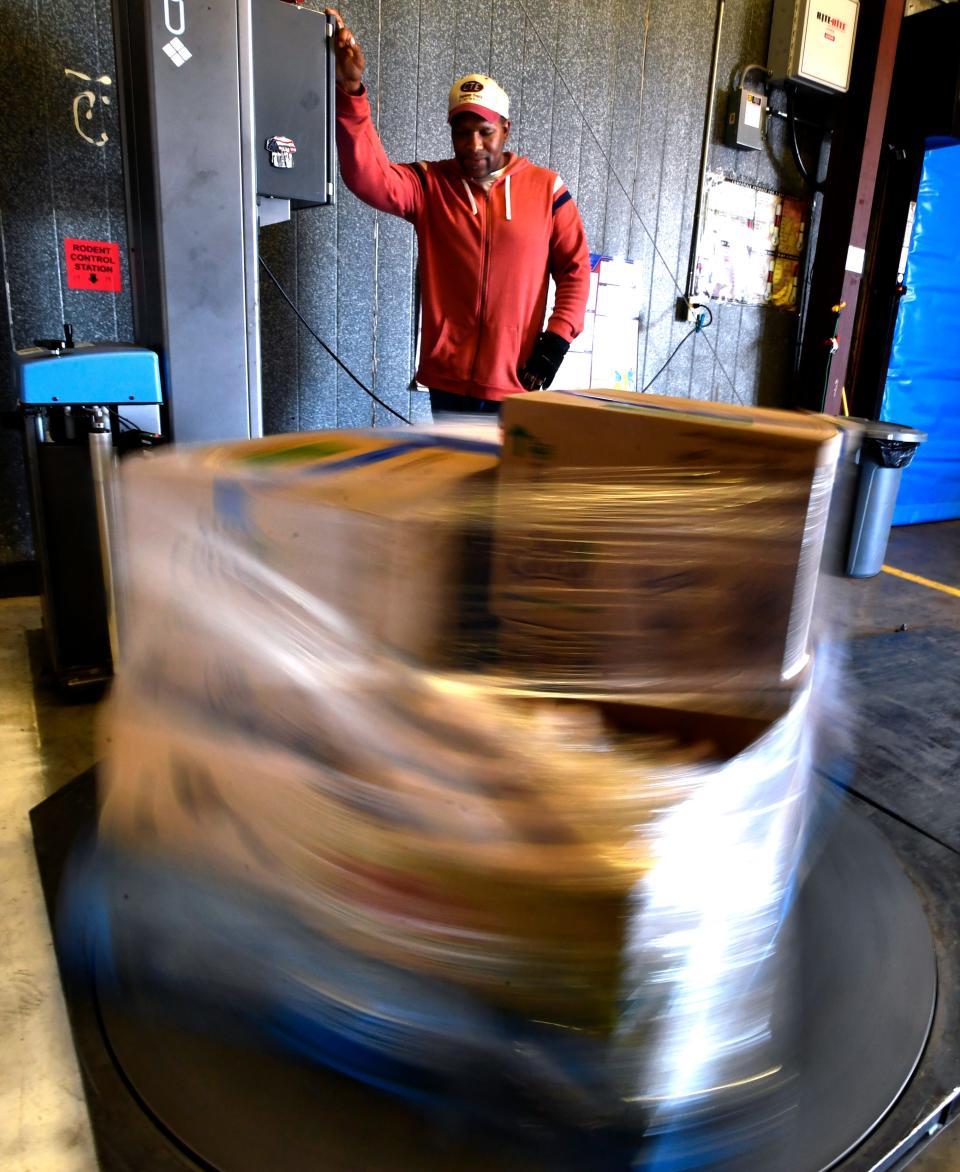
The city is richly served, Dembach said, "but once you get outside of Abilene, that changes drastically. There is need in Abilene, but it's greater in rural areas where resources are fewer or nonexistent.
The government prohibits commodities from crossing county lines, so a resource must be found in each county. Due to a lack of volunteers, a pantry may be open once a week, or once a month.
This is where the mobile pantry comes into play.
"Everything that goes through here is touched," Dembach said. That includes checks for expiration dates and product integrity
"If it doesn't meet muster, unfortunately it has to get tossed," Dembach said.
Partners share in the maintenance cost of the food bank.
"But we are a lean, mean, fighting machine here," he said, smiling.
Getting the items
The food bank tries to delivery items, especially to outlying areas. But the cost of fuel, which has been up and down recently, and driver availability have an impact on that effort, Dembach said.
"The folks in Colorado City come to pick up with a flatbed trailer," he said.
Partners, such as Carroll, otherwise come to the North First facility to pick up items.
The food bank posts what items that are available for their partners "so they can place an order," he said. "We fulfill those orders within 24 hours."
Carroll said he likes to come in because something he'd like might have just come in and not yet be posted on the availability list.
"There may be stuff laying around and I ask, 'Hey, can I have that?'" he said, laughing. "I can get the latest by coming in."
A bonus item is meat, which is put in freezers at the food bank and then into freezers at the destination.
Meat is something that has to be purchased, Carroll said. Some pantries just take free items.
"I'm thrifty but I'm still going to buy," he said. A U.S. Department of Agriculture price is a good deal. "We are extremely dependent on them. If we had to buy all this stuff at the store, we couldn't give away one-tenth of what we do."
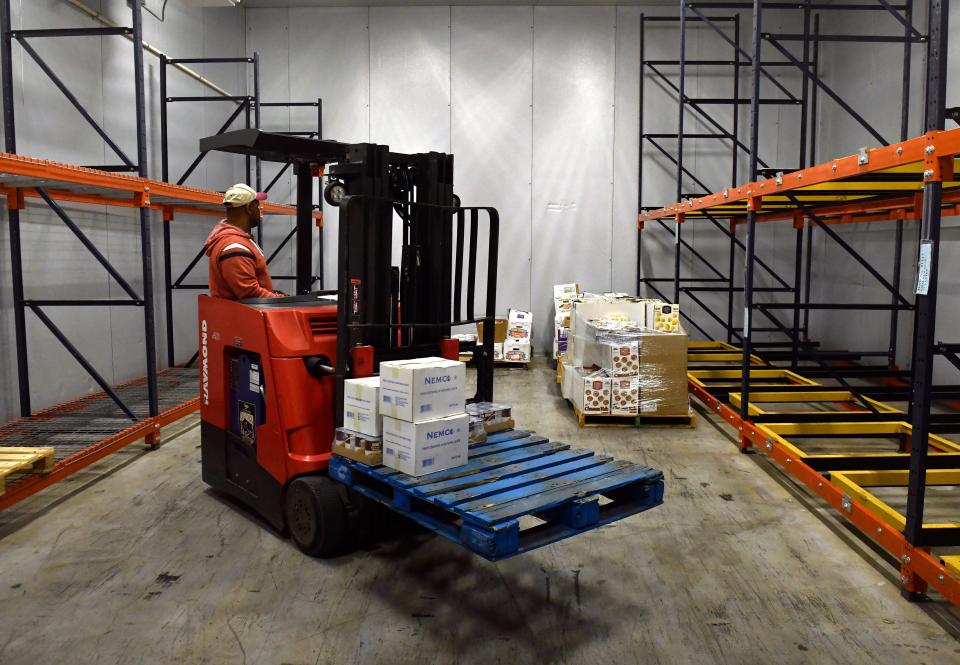
Volunteers are a must
"We cannot fulfill our mission with our small staff exclusively," Dembach said. "Volunteers are paramount for us to accomplish our goals. Fortunately, we are pretty well blessed with volunteers."
Food Bank of West Central Texas employs 13.
Volunteer sources include the general community, churches, Dyess Air Force Base and civic organizations.
"They may serve for only an hour or two, but that helps us," he said.
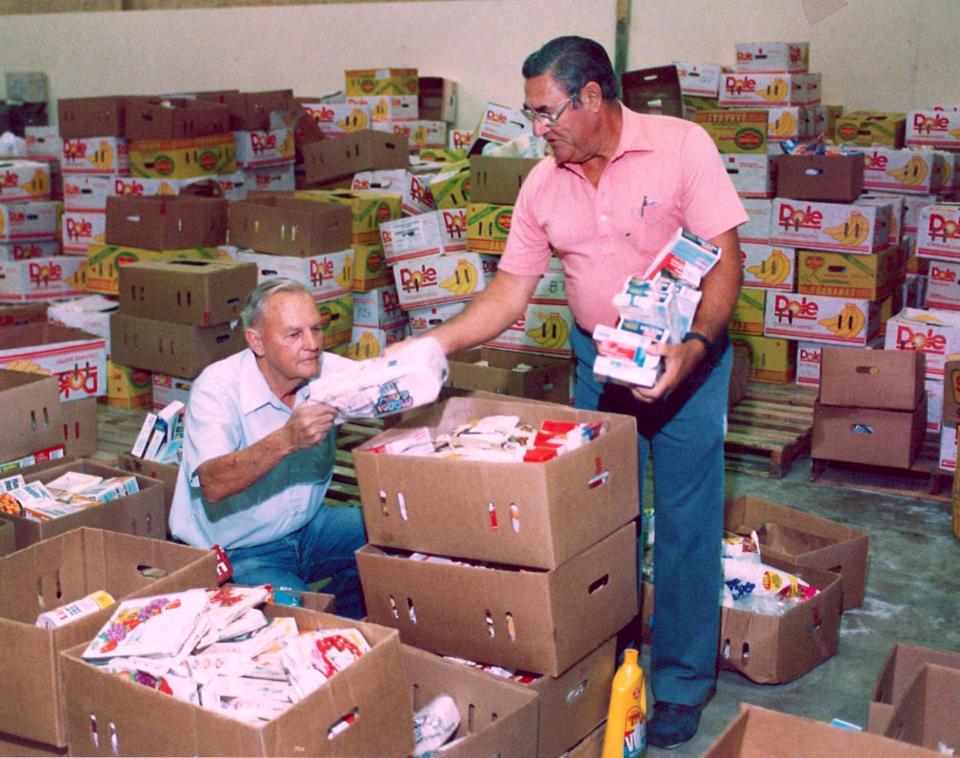
A key need is sorting what comes in.
Earlier this month, a group of volunteers sort a load of sweet potatoes - 42,000 pounds worth - that came in loose binds. The workers were charged with putting those in 3-, 5- and 10-pound bags for distribution. The bag size depends on what goes in - white potatoes generally go in 10-pound bags while carrots go in 3-pounders.
"It is more cost effective for us to order produce loose and in bins," Dembach said.
"It's fun," he said. It's not complicated work and groups. "If you've ever seen it done, it's actually quite entertaining."
Last year, teachers called with a request to use second- and third-graders on a project.
"We just happened to have a bin of loose carrots on site," Dembach said. "Carrots were flying, but they got so much accomplished. They had fun doing it and it was a great learning experience. They asked excellent questions.
"The teachers had the opportunity to explain there are people who don't have food and you are helping to supply that, and that got them even more jazzed."
A few weeks before that, it was various sizes of cabbage.
"We had great fun with that," Dembach said.
Volunteers are a win-win-win, he said. The food bank benefits, volunteers benefit and, ultimately, those receiving food benefit.

Expansion planned
The goal of the expansion project is to provide access during non-traditional hours, Dembach said.
That would be after work - those who need items are working and can't take off from work during the day - and weekends, Wagstaff said.
The food bank, using its expansion area, would be open two or three times a week as a drive-thru pantry.
"Think a beer barn, but for good stuff," Dembach said, laughing.
This is a need that food suppliers are trying to meet, he said. The Methodist pantry is open from 4-8 p.m. Tuesdays, he said.
"Its a niche that has not been filled well," he said. "We recognize that need and want to provide that service, here on site."
Details on exactly how the setup would operate are being planned, he said.
But, Dembach said, it's a way to take what has been working for 40 years and push it toward the next 40 years.
"We're trying to help as many people across the board as we can," he said.
This article originally appeared on Abilene Reporter-News: Food Bank hits 40: Regional distribution center feeds need that grows

